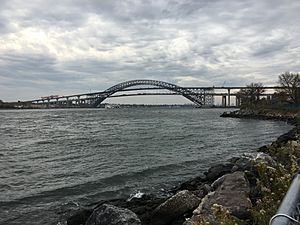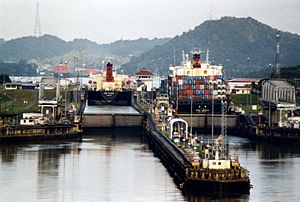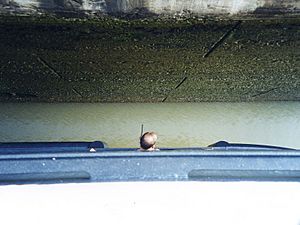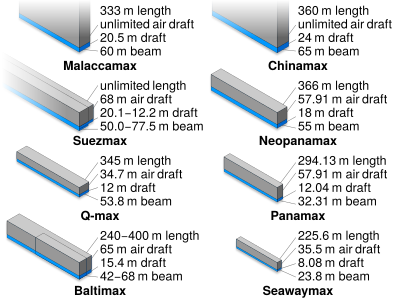Panamax facts for kids
Quick facts for kids General characteristics Panamax |
|
|---|---|
| Tonnage | 52,500 DWT |
| Length | 289.56 m (950 ft) |
| Beam | 32.31 m (106 ft) |
| Height | 57.91 m (190 ft) |
| Draft | 12.04 m (39.5 ft) |
| Capacity | 5,000 TEU |
| Notes | Opened 1914 |
| General characteristics New Panamax | |
|---|---|
| Tonnage | 120,000 DWT |
| Length | 366 m (1,201 ft) |
| Beam | 51.25 m (168 ft) |
| Height | 57.91 m (190 ft) |
| Draft | 15.2 m (50 ft) |
| Capacity | 14,000 TEU |
| Notes | Opened 2016 |
Panamax and New Panamax (also called Neopanamax) are special terms. They describe the maximum size a ship can be to travel through the Panama Canal. The Panama Canal Authority (ACP) sets these rules. They publish them in a guide called "Vessel Requirements."
These rules cover many things. They include how wide, long, deep, and tall a ship can be. They also cover how ships should be built and how they communicate. These rules are important because they affect how ships are designed around the world.
The first Panamax rules started when the canal opened in 1914. In 2009, new rules called New Panamax were made. These came into effect when the canal's third set of locks opened on June 26, 2016. These new locks are much bigger than the old ones. Ships that are too big for the original Panamax rules are called post-Panamax or super-Panamax.
It can be tricky for very large ships to pass through the canal. A Panamax ship fits very tightly in the old locks. This means it needs careful control and can take longer to pass through. Also, the biggest ships cannot pass each other safely in some narrow parts of the canal. So, the canal sometimes uses a one-way system for these ships.
Contents
What Limits Ship Sizes?


The size of ships that can use the Panama Canal is limited by several things. The most important limits come from the canal's original lock chambers. Each of these locks is about 110 ft (33.53 m) wide and 1,050 ft (320.04 m) long. The part of the lock that ships can actually use is about 1,000 ft (304.8 m) long.
The depth of the water in the canal also matters. The shallowest part is about 41.2 ft (12.56 m) deep. Also, the height of bridges over the canal limits how tall a ship can be. These bridges include the Bridge of the Americas, the Centennial Bridge, and the Atlantic Bridge.
Ship Length Limits
For the original locks, the longest a ship can be is 950 ft (289.56 m). There are a few exceptions:
- Container ships and passenger ships can be up to 965 ft (294.13 m) long.
- Tugboat and barge combinations that are strongly connected can be 900 ft (274.32 m) long.
- Other non-powered vessels pulled by tugs can be 850 ft (259.08 m) long.
The New Panamax rules allow ships to be much longer, up to 366 m (1,201 ft).
Ship Width Limits
For the original locks, the widest a ship can be is 106 ft (32.31 m). There's a small exception: a ship can be 107 ft (32.61 m) wide if it doesn't sit too deep in the water (less than 37 ft (11.3 m)).
New Panamax ships can be wider. They were first allowed to be 49 m (161 ft) wide. In June 2018, this was increased to 51.25 m (168.14 ft).
Ship Draft Limits
The draft of a ship is how deep it sits in the water. The maximum draft for the original locks is 39.5 ft (12.04 m). This measurement is based on the fresh water in Lake Gatún, which is part of the canal. The density of the water changes with temperature and saltiness, affecting how deep a ship floats.
Sometimes, if there isn't much rain, the water level in Lake Gatún can drop. When this happens, the canal authority might have to reduce the maximum allowed draft for ships. They usually announce this a few weeks ahead of time.
New Panamax ships can have a deeper draft, up to 15.2 m (49.9 ft). However, when the new locks first opened, the draft was limited due to low rainfall.
Ship Height Limits
The height of a ship, measured from the waterline to its highest point, is limited to 190 ft (57.91 m). This limit applies to both Panamax and New Panamax ships. It's important so ships can pass under the Bridge of the Americas near Balboa. In some cases, a ship can be 205 ft (62.5 m) tall if the water level is very low.
How Much Cargo Can They Carry?
A typical Panamax cargo ship can carry about 52,500 tonnes of cargo when going through the canal. This is because of the draft limits. These ships can also carry around 5,000 TEU containers.
New Panamax ships are much larger. They can carry up to 120,000 tonnes of cargo. They can also hold about 13,000 TEU containers.
Ship Size Records
The longest ship to ever use the original locks was the San Juan Prospector. It was an ore-bulk-oil carrier, measuring 973 ft (297 m) long and 106 ft (32 m) wide.
The widest ships to pass through the original locks were four battleships: the South Dakota class and Iowa class classes. They were about 108 ft 2 in (32.97 m) wide. This left less than 6 in (15 cm) of space between the ships and the lock walls!
Panama Canal Expansion
The idea of building new, larger locks for the Panama Canal came up as early as the 1930s. This was to help with traffic and allow bigger ships to pass. However, the project was stopped in 1942.
In 2006, the people of Panama voted in a special election. They approved a plan to expand the Panama Canal. About 78% of voters supported the project. Construction started in 2007. After some delays, the new, larger locks opened for ships on June 26, 2016.
What is Neopanamax?
The building of these new, larger locks led to the creation of the Neopanamax or New Panamax ship size. These new locks are much bigger: 427 m (1,401 ft) long, 55 m (180 ft) wide, and 18.3 m (60.0 ft) deep.
Ship designers now use these new dimensions when creating large container ships. With the new locks, the Panama Canal can handle ships that are up to 366 m (1,201 ft) long. They can be 51.25 m (168.14 ft) wide and have a 15.2 m (49.9 ft) draft. These ships can carry up to 14,000 twenty-foot equivalent units (TEU) containers. Before the expansion, the canal could only handle ships with about 5,000 TEU containers. Neopanamax ships can also carry up to 120,000 tonnes of cargo.
Impact on Ports Worldwide

Many ports around the world had to change to handle the new, bigger Neopanamax ships. Ports like New York and New Jersey, Norfolk, and Baltimore on the East Coast of the United States made their harbors deeper. They now have a depth of at least 50 feet (15 m).
The Port of Miami also deepened its harbor in a project called "Deep Dredge." It is the closest deep-water port to the Panama Canal in the US. In England, the port of Liverpool built a new container terminal called Liverpool2. This allows large ships to dock in the river.
In 2017, the Port Authority of New York and New Jersey raised the height of the Bayonne Bridge. This cost $1.7 billion. It allows New Panamax ships to reach container terminals in Port Newark–Elizabeth. Before this, only one terminal could handle these huge ships.
Other ports, like Jacksonville, Florida, and Mobile, Alabama, are also working to deepen their harbors. They want to attract the business from these larger ships.
Impact on Older Ships
Because of the canal's expansion, the demand for older, smaller 'Panamax' ships has dropped a lot. Many of these ships, some as young as seven years old, have been sold for scrap metal. Some have even been made wider to fit the new canal.
Comparing Ship Sizes
| Original locks | Panamax | Third locks | Neo-Panamax | |
|---|---|---|---|---|
| Length | 320.04 m (1,050 ft) | 294.13 m (965 ft) | 427 m (1,400 ft) | 366 m (1,200 ft) |
| Width | 33.53 m (110 ft) | 32.31 m (106 ft) | 55 m (180 ft) | 51.25 m (168.1 ft) |
| Draft | 12.56 m (41.2 ft) | 12.04 m (39.5 ft) | 18.3 m (60 ft) | 15.2 m (50 ft) |
| TEUs | 5,000 | 13,000 | ||
| Tonnage | 52,500 DWT | 120,000 DWT | ||
Post-Panamax Ships
Post-Panamax or over-Panamax ships are those that are too big for the original Panama Canal locks. These include huge supertankers and the largest modern container and passenger ships.
The first post-Panamax ship was the RMS Queen Mary, launched in 1934. It was built with a 118 ft (36 m) width. This meant it could not use the Panama Canal. When it moved to Long Beach, California, in 1967, it had to sail all the way around Cape Horn at the tip of South America.
Until World War II, the United States Navy designed all its warships to fit through the Panama Canal. However, the Montana-class battleship, designed around 1940, was the first US Navy warship design that would have been too big. This ship was never built. The rule about fitting the canal was officially removed for US Navy warships in 1940.
See also
 In Spanish: Panamax para niños
In Spanish: Panamax para niños
- Cargo ship sizes
- List of Panamax ports







